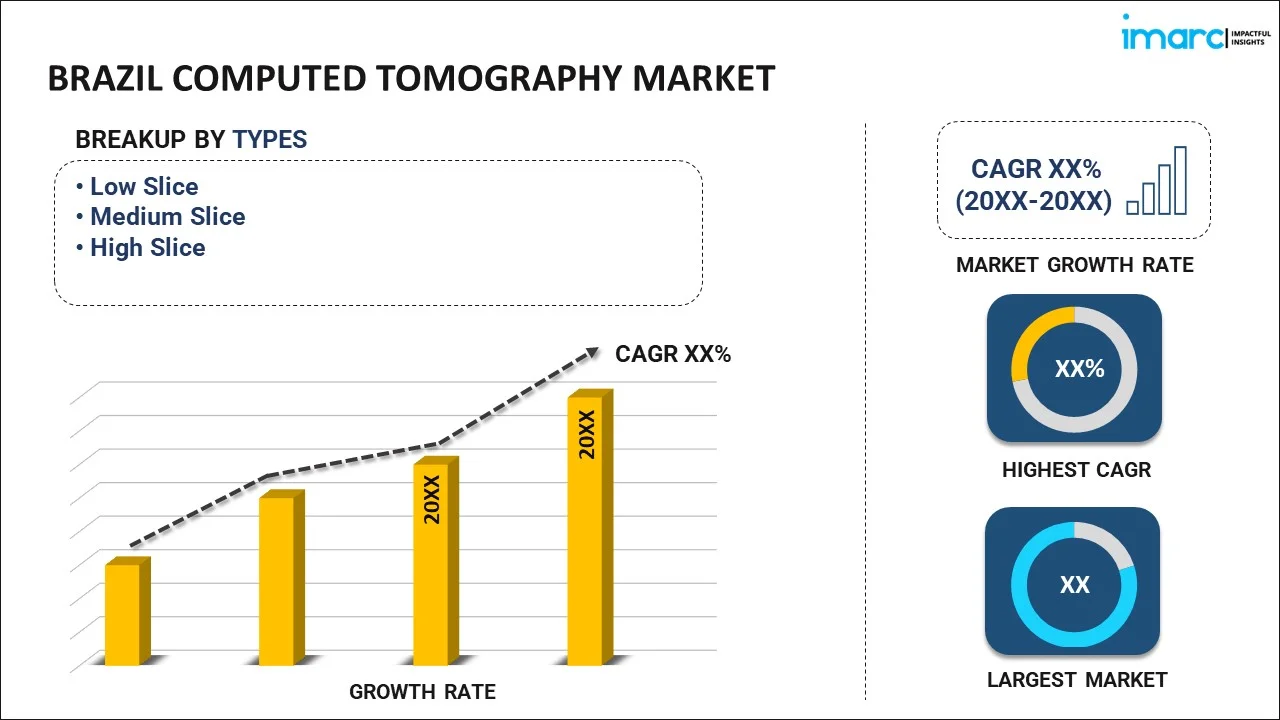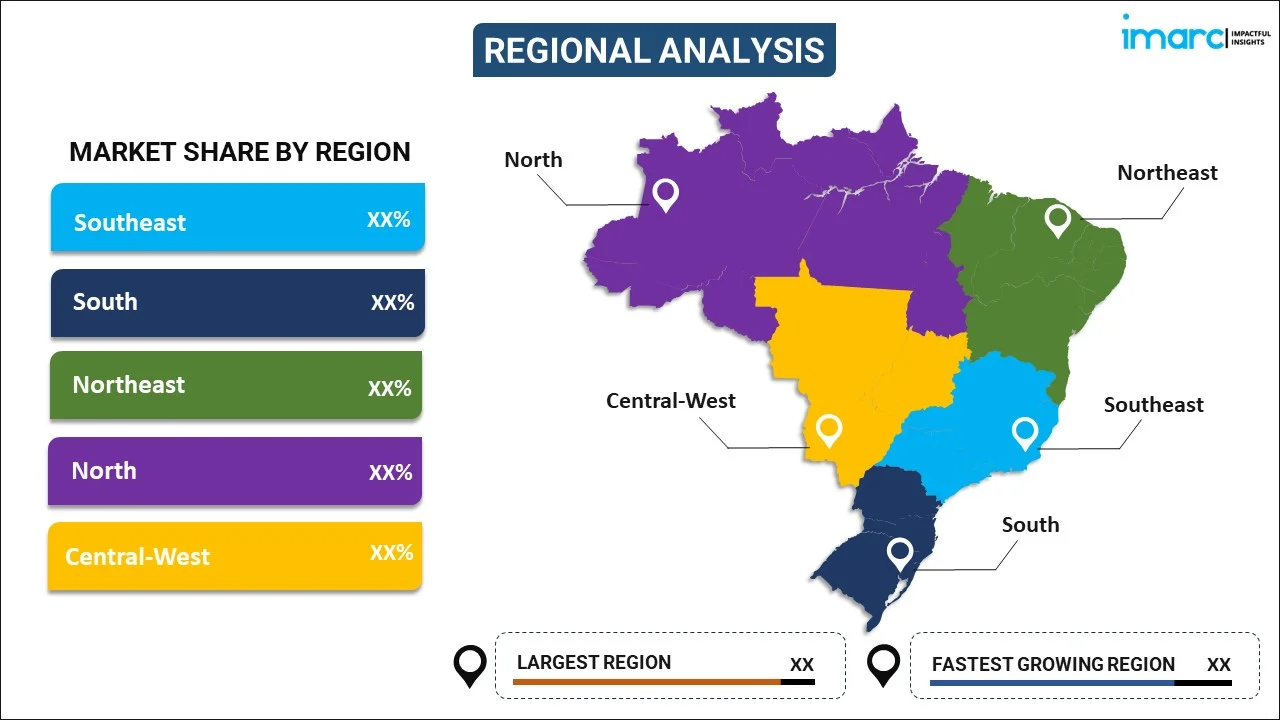
Brazil Computed Tomography Market Report by Type (Low Slice, Medium Slice, High Slice), Application (Oncology, Neurology, Cardiovascular, Musculoskeletal, and Others), End User (Hospitals, Diagnostic Centers, and Others), and Region 2025-2033
Market Overview:
Brazil computed tomography market size reached USD 238.9 Million in 2024. Looking forward, IMARC Group expects the market to reach USD 346.9 Million by 2033, exhibiting a growth rate (CAGR) of 4.11% during 2025-2033. The improving healthcare infrastructure and continuous investments in upgrading and expanding healthcare facilities, increasing prevalence of chronic diseases and non-communicable conditions, and the integration of advanced technologies represent some of the key factors driving the market.
|
Report Attribute
|
Key Statistics
|
|---|---|
|
Base Year
|
2024 |
|
Forecast Years
|
2025-2033
|
|
Historical Years
|
2019-2024
|
| Market Size in 2024 | USD 238.9 Million |
| Market Forecast in 2033 | USD 346.9 Million |
| Market Growth Rate (2025-2033) | 4.11% |
Computed tomography (CT), also known as CAT scanning, is a medical imaging technique that uses X-rays and computer technology to create detailed cross-sectional images of the body. It provides a clear and comprehensive view of internal structures, allowing for precise diagnosis and evaluation of various medical conditions. It enables medical professionals to visualize intricate anatomical details and pinpoint abnormalities with exceptional precision. It is relatively quick, non-invasive, and generates cross-sectional images of the body. It offers high-resolution images, aiding in the accurate diagnosis of medical conditions. It enables early detection of diseases, including cancer and vascular conditions. It assists in planning surgeries and other medical interventions and allows for the monitoring of treatment progress and post-operative recovery. It is widely used for diagnosing conditions like tumors, fractures, infections, and vascular diseases. It is also utilized as an alternative to traditional colonoscopy for colorectal cancer screening.
Brazil Computed Tomography Market Trends:
The growing healthcare infrastructure and continuous investments in upgrading and expanding healthcare facilities in Brazil represent one of the key factors positively influencing the market. This includes the establishment of modern hospitals and diagnostic centers, which are equipped with state-of-the-art CT scanners. Along with this, governing agencies of the country are focusing on improving healthcare access and quality and promoting the installation of CT machines to meet the rising demand for diagnostic services. Additionally, the increasing prevalence of chronic diseases and non-communicable conditions is driving the need for advanced diagnostic tools like CT scanners. Apart from this, the expanding aging population in Brazil, which is more prone to several chronic diseases, such as cancer, cardiovascular disorders, and neurological conditions, is strengthening the growth of the market. CT scanning aids in the early detection, diagnosis, and monitoring of these ailments, contributing to improved patient outcomes. As a result, healthcare providers in Brazil are investing in CT technology to meet the diagnostic challenges posed by various health conditions. Furthermore, rising preferences of individuals are encouraging hospitals and clinics across Brazil to upgrade their imaging departments with the latest CT technology to remain competitive and meet the expectations of their clientele. Moreover, the introduction of multi-slice CT scanners with higher spatial resolution and faster image acquisition is improving diagnostic capabilities. These advanced scanners can produce highly detailed images very quickly, reducing patient discomfort and enhancing diagnostic accuracy. Additionally, the integration of artificial intelligence (AI) and machine learning algorithms into CT image analysis is enabling automated image processing, aiding radiologists in the interpretation of complex images.
Brazil Computed Tomography Market Segmentation:
IMARC Group provides an analysis of the key trends in each segment of the brazil computed tomography market report, along with forecasts at the country levels for 2025-2033. Our report has categorized the market based on type, application, and end user.
Type Insights:

- Low Slice
- Medium Slice
- High Slice
The report has provided a detailed breakup and analysis of the market based on the type. This includes low slice, medium slice, and high slice.
Application Insights:
- Oncology
- Neurology
- Cardiovascular
- Musculoskeletal
- Others
A detailed breakup and analysis of the market based on the application have also been provided in the report. This includes oncology, neurology, cardiovascular, musculoskeletal, and others.
End User Insights:
- Hospitals
- Diagnostic Centers
- Others
The report has provided a detailed breakup and analysis of the market based on the end user. This includes hospitals, diagnostic centers, and others.
Regional Insights:

- Southeast
- South
- Northeast
- North
- Central-West
The report has also provided a comprehensive analysis of all the major regional markets, which include Southeast, South, Northeast, North, and Central-West.
Competitive Landscape:
The market research report has also provided a comprehensive analysis of the competitive landscape in the market. Competitive analysis such as market structure, key player positioning, top winning strategies, competitive dashboard, and company evaluation quadrant has been covered in the report. Also, detailed profiles of all major companies have been provided.
Brazil Computed Tomography Market Report Coverage:
| Report Features | Details |
|---|---|
| Base Year of the Analysis | 2024 |
| Historical Period | 2019-2024 |
| Forecast Period | 2025-2033 |
| Units | Million USD |
| Scope of the Report | Exploration of Historical Trends and Market Outlook, Industry Catalysts and Challenges, Segment-Wise Historical and Future Market Assessment:
|
| Types Covered | Low Slice, Medium Slice, High Slice |
| Applications Covered | Oncology, Neurology, Cardiovascular, Musculoskeletal, Others |
| End Users Covered | Hospitals, Diagnostic Centers, Others |
| Regions Covered | Southeast, South, Northeast, North, Central-West |
| Customization Scope | 10% Free Customization |
| Post-Sale Analyst Support | 10-12 Weeks |
| Delivery Format | PDF and Excel through Email (We can also provide the editable version of the report in PPT/Word format on special request) |
Key Questions Answered in This Report:
- How has the Brazil computed tomography market performed so far and how will it perform in the coming years?
- What has been the impact of COVID-19 on the Brazil computed tomography market?
- What is the breakup of the Brazil computed tomography market on the basis of type?
- What is the breakup of the Brazil computed tomography market on the basis of application?
- What is the breakup of the Brazil computed tomography market on the basis of end user?
- What are the various stages in the value chain of the Brazil computed tomography market?
- What are the key driving factors and challenges in the Brazil computed tomography?
- What is the structure of the Brazil computed tomography market and who are the key players?
- What is the degree of competition in the Brazil computed tomography market?
Key Benefits for Stakeholders:
- IMARC’s industry report offers a comprehensive quantitative analysis of various market segments, historical and current market trends, market forecasts, and dynamics of the Brazil computed tomography market from 2019-2033.
- The research report provides the latest information on the market drivers, challenges, and opportunities in the Brazil computed tomography market.
- Porter's five forces analysis assist stakeholders in assessing the impact of new entrants, competitive rivalry, supplier power, buyer power, and the threat of substitution. It helps stakeholders to analyze the level of competition within the Brazil computed tomography industry and its attractiveness.
- Competitive landscape allows stakeholders to understand their competitive environment and provides an insight into the current positions of key players in the market.
Need more help?
- Speak to our experienced analysts for insights on the current market scenarios.
- Include additional segments and countries to customize the report as per your requirement.
- Gain an unparalleled competitive advantage in your domain by understanding how to utilize the report and positively impacting your operations and revenue.
- For further assistance, please connect with our analysts.
 Inquire Before Buying
Inquire Before Buying
 Speak to an Analyst
Speak to an Analyst
 Request Brochure
Request Brochure
 Request Customization
Request Customization




.webp)




.webp)












